30 Genius WD-40 Uses | Popular and Unusual Ways to Use WD-40
By: Shifrah Combiths (Readers Digest)
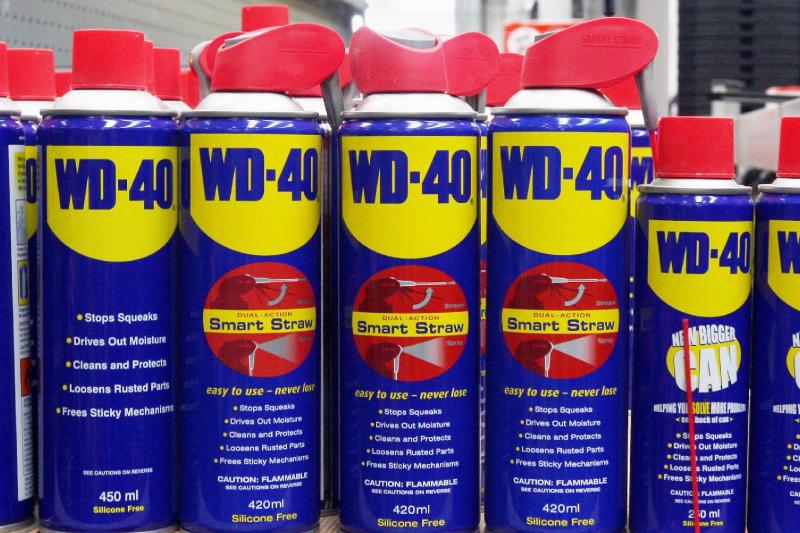

WD-40 is half of the Red Neck repair kit. 'nuff said.


I only just discovered that WD-40 can do so much more than fix squeaky doors—and I've been writing about cleaning and organizing for well over a decade. After speaking with cleaning and chemistry experts, I'm well-versed in how the product works and know all of the genius WD-40 uses the pros employ. I, for one, will never be without my own can (or several) again!
WD-40 meets all of my criteria for a household cleaning product everyone should have on hand: It's extremely versatile and inexpensive, and it both solves and prevents common problems. Ahead, you'll learn how a WD-40 expert and a chemist suggest using the product around your house.
The history of WD-40
The name WD-40 hints at the story of how the product came to be, says WD-40 brand manager Stepan Harmanlikian. The product was invented in a San Diego lab in 1953 by Rocket Chemical Company in an effort to develop rust-prevention solvents and degreasers for the aerospace industry. "After 39 attempts, the company's three employees finally perfected their water-displacing formula on the 40th try," he says. That formula became WD-40 Multi-Use Product.
WD-40 has a wide variety of uses, including cleaning several notoriously difficult but common types of household messes. And there are even more surprising WD-40 uses, ranging from getting gum unstuck to detangling jewelry.
How does WD-40 work?
While the exact composition of WD-40 is such a closely guarded trade secret that the formula is locked in a California bank vault, the product's safety data sheet notes that it contains organic solvents, propellants and mineral oil. Erika Womack, PhD, a chemist with the state of Mississippi, an associate research professor and the director of the Chemical Laboratory at Mississippi State University, explains that WD-40 works through lubrication, water displacement, rust prevention and cleaning.
"When sprayed on moving parts, WD-40 leaves behind a thin film of lubricating oil that helps reduce friction, which is useful for loosening hinges, nuts and bolts," she says. "WD-40 also helps protect against moisture-related issues and prevent rust and corrosion."
Since water displacement is part of WD-40's name (yes, that's what the WD stands for) and a big factor in how it works, it's helpful to understand a bit more about the process. "Water displacement by the oils in WD-40 is due to the low surface tension," Womack explains. "The molecules in oil are typically nonpolar, while water molecules are polar. This difference in polarity results in different cohesive forces between the molecules. The oil molecules experience attractive forces among themselves, and they also interact less favorably with the water molecules due to the difference in polarity."
What does that actually mean? "When WD-40 is introduced onto the water surface, it tends to spread out and push water away due to differences in surface tension between water and WD-40," Womack says.
Rust prevention occurs through the combination of the lubricating oil and the water-displacing properties of WD-40, which "leaves a protective barrier that inhibits the oxidation process," she says. Lastly, the "solvents in WD-40 help break down and dissolve dirt, grime and adhesives," which makes WD-40 an excellent cleaner in some tricky spots, Womack says.
Popular WD-40 uses
Below are the most common WD-40 uses, plus tips for making them work in your home.
Fix squeaky hinges
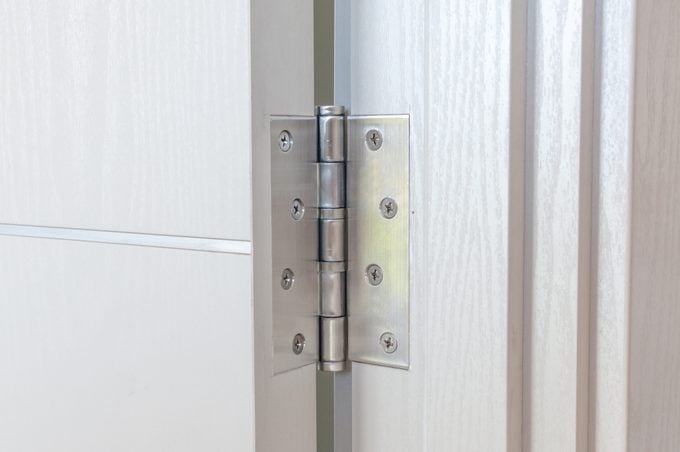
RAWINTANPIN/GETTY IMAGES
Silencing squeaky hinges is one of the most well-known uses for WD-40 and is probably the reason you have a canister of it in your toolbox. WD-40 can be used on all kinds of noisy hinges, including those on doors, ladders, folding chairs, pruning shears and more. Spray the hinge with a blast WD-40. It will be squeak-free in seconds.
Remove sticky residue
Another of the most popular WD-40 uses is removing sticky residue , such as duct tape residue left on walls or storage bins, stubborn labels on the bottom of glassware or residue from the stickers your kid used to “decorate” the back window of your minivan. To use it, spray WD-40 over the affected area, let it sit for a few minutes, then wipe it away with a cloth or a sponge.
Loosen stuck items
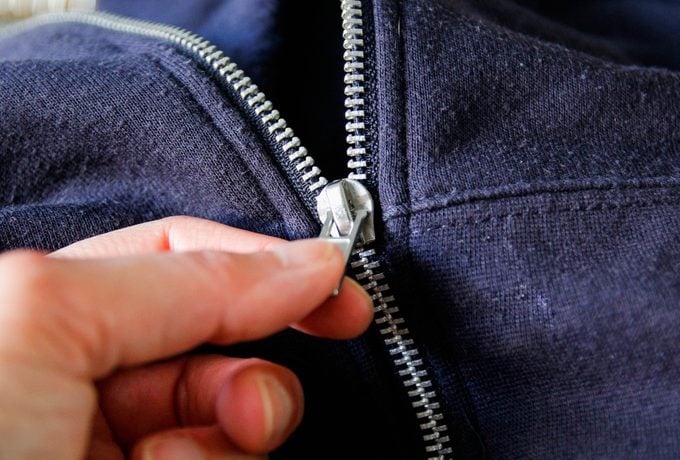
KINGA KRZEMINSKA/GETTY IMAGES
From a zipper that won’t budge to rusted-together nuts and bolts, stuck items are no match for WD-40. Simply spray WD-40 on the trouble spot and allow it to penetrate the area. A jammed zipper may need only a few seconds, while rusted-together nuts and bolts may need up to 30 minutes before they get moving again.
Maintain tools
WD-40 can clean rust and grime from the blades and tines of all your tools. Spray the metal parts of the tool with WD-40, allow it to sit for a few minutes, then wipe it clean with a rag.
Remove wax and glue from surfaces
Get wax and glue off of surfaces without scraping, scrubbing or frustration. Grab some WD-40, spray it on the affected area, allow it to sit for a few minutes, then remove the wax or glue from the surface with a rag.
Cleaning uses for WD-40
WD-40 isn’t just good for unsticking things that are annoyingly stuck. You can also use it to clean bathrooms, floors, stainless steel and more.
Polish stainless steel
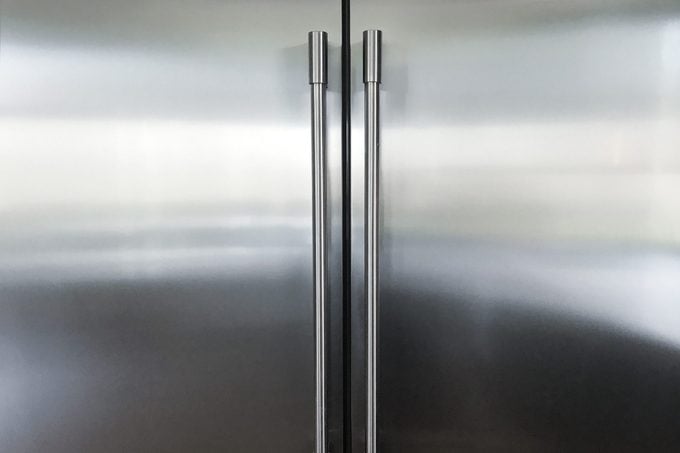
TRIGGERPHOTO/GETTY IMAGES
Cleaning stainless steel appliances needs to be a regular part of your cleaning schedule if you want a smudge- and fingerprint-free kitchen. WD-40 can help clean your stainless steel appliances and polish them at the same time. Spray the product onto a rag and buff it into the stainless steel, going with the grain.
Spot-treat stains and scuffs on floors
Cleaning floors is a constant chore, but WD-40 makes it easy to spot-treat scuffs and stains on your floors. Spray the product on the stained area, let it set for a few minutes, then wipe it clean with a rag. The process even works for spilled paint! Just make sure to wipe up any excess product to prevent slips and falls.
Erase crayon marks
Per Harmanlikian, WD-40 is excellent at eliminating crayon marks from just about anything, including wooden furniture, floors and walls. Spray WD-40 onto a rag and rub the affected area until the crayon mark comes off.
Outdoor uses for WD-40
As you might guess, a product that specializes in water displacement and lubrication is useful in outdoor spaces too. Read on to learn about some great WD-40 uses around the house.
Protect pipes from freezing
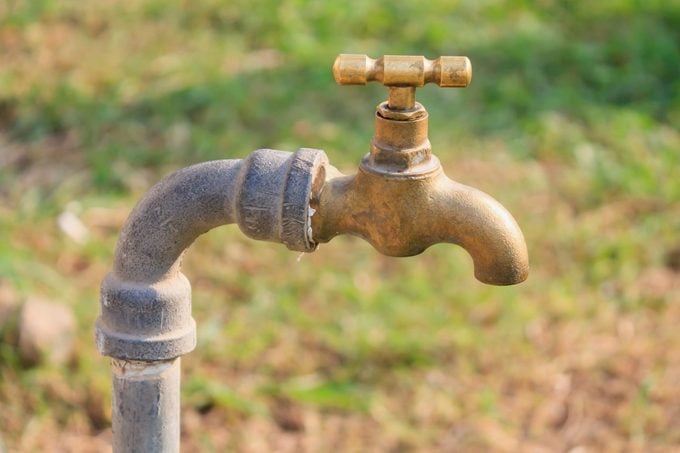
KWANGMOOZAA/GETTY IMAGES
Exposed pipes can freeze in the winter, which can cause big and expensive problems if they burst. In the fall, before cold weather sets in, coat exposed spigots and pipes with a layer of WD-40 to help keep moisture from accumulating.
Prevent snow buildup on windows
Does the weather forecast predict a big winter snowstorm? You can’t stop the snow from falling, but you can prevent it from building up on your house’s windows with this genius WD-40 use. Just spray WD-40 over the outside of your windows before it starts flurrying, and the snow won’t stick.
Repel pests
Spray WD-40 on eaves to prevent wasps from building nests underneath, and use it around exterior window sills and door frames to keep spiders away. According to A-Z Animals, WD-40 repels insects by making surfaces slippery and harder for bugs and pests to grasp onto. Plus, they don’t like its odor. WD-40 also has staying power; the rain won’t wash it away, making it an effective repellant for up to a year.
Keep wooden handles on garden tools splinter-free
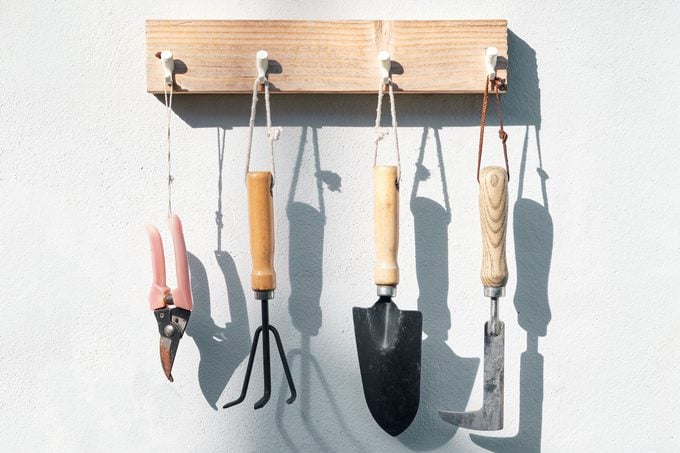
STUDIO-OMG/GETTY IMAGES
Over time, wooden handles can dry out and eventually splinter, making them not only uncomfortable but also dangerous to use. To prolong the life of your wood-handled gardening tools, refresh them with WD-40. Newer tools need only a light coating, sprayed on and rubbed in with a soft cloth. You may need to sand the handles of older tools before wiping them down with WD-40.
Winterproof boots and shoes
Here’s one of the great WD-40 uses you might not have thought of. Waterproof your winter boots and shoes by giving them a coat of WD-40. It’ll act as a barrier so water can’t penetrate the material.
You can also use WD-40 to remove ugly salt stains from boots and shoes during the winter months. Just spray WD-40 onto the stains and wipe with a clean rag. Your boots and shoes will look almost as good as new.
WD-40 uses for your car
You can use WD-40 to spruce up both the interior and exterior of your car . Just be careful not to use it on plastic bits of the car, as it may damage them.
Polish car exteriors
To remove dirt, grime and paint marks left on your vehicle by other cars, spray WD-40 on a soft cloth and wipe on trouble spots.
Make dashboards and leather shine
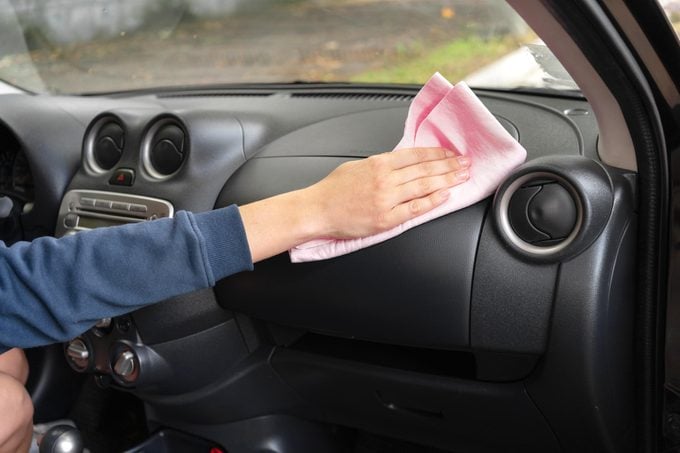
ANDRII LYSENKO/GETTY IMAGES
To make leather seats and dashboards gleam, spray WD-40 onto a sponge, then wipe the surfaces. Let the product set for about five minutes, then wipe it dry with a soft cloth. Double-check that your leather interior is not coated with plastic before you start spraying. If it is, avoid using WD-40 on it.
Remove bird poop
Cleaning bird poop from cars can make a bigger mess than you started with if you do it the wrong way. To clean it without having to scrape or scrub, spray the area with WD-40, allow it to sit for about a minute and then wipe or rinse it away.
Restore license plates
To help restore a license plate that is beginning to rust, spray it with WD-40 and wipe it with a clean rag. This will remove light surface rust and will help prevent more rust from forming. It’s an easy way to clean up lightly rusted plates, and it won’t leave a greasy feel.
Clean dead bugs from grilles and windshields
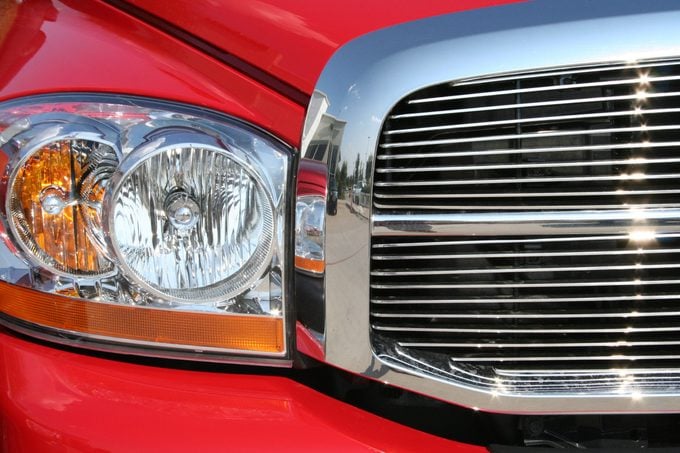
SDI PRODUCTIONS/GETTY IMAGES
WD-40 is ideal for getting bug splatters off your car’s grille or windshield without damaging the paint. Spray affected areas with WD-40, let the product sit for up to an hour and then rinse it clean. You can also use WD-40 to remove sap and tar from your car without damaging the paint.
Clean oil spots from your driveway
Did a leaky oil pan leave a big, ugly spot in the middle of your concrete driveway? To get rid of an unsightly oil spot, spray it with a generous amount of WD-40 and then hose it down with water.
Unusual uses for WD-40
“Legend has it that police officers used WD-40 Original Formula to lubricate a naked burglar stuck in an air vent and a bus driver [used it] to remove a python from the undercarriage of a bus,” Harmanlikian shares. While you probably won’t find yourself in either of these quandaries, WD-40 has some other unusual uses that you may find applicable.
Get grease or super glue off your hands
If you’ve ever gotten some grease or super glue on your hands, you know it can feel like an exercise in futility to try to wash them with soap and water. Next time, grab some WD-40, apply the product to your palms and rub it around. Wash immediately with soap and water.
Remove gum
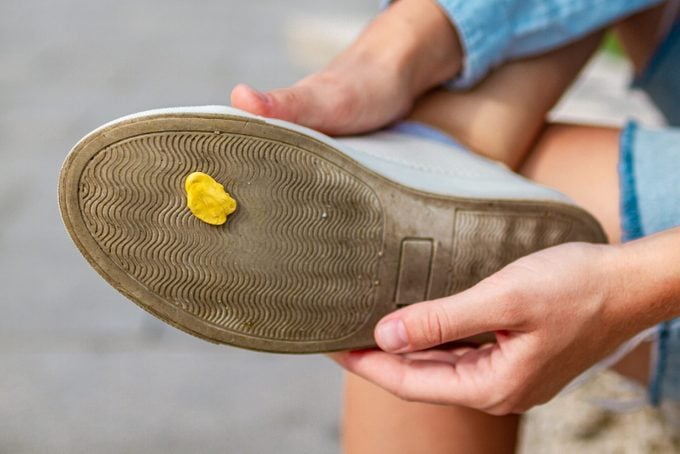
SIARHEI KHALETSKI/GETTY IMAGES
Whether gum has gotten stuck to the bottom of your shoes, the wall, the floor or even in your hair, WD-40 can help, Harmanlikian says. Spray it on the affected area, allow it to penetrate for about a minute and then ease the gum off.
Clean poop off shoes
If you stepped in a mess, remove as much of the poop as possible with a paper towel, then spray WD-40 onto the affected area of the sole of your shoe. It will help loosen the poop so you can scrub it off more easily. Bonus: WD-40 will help keep poop and other dirt from sticking to your shoes in the first place.
Disguise scratches on ceramic, linoleum, marble and wood
WD-40 can fill in scratches on surfaces, including ceramic, linoleum, marble and wood, making them appear less prominent. Spray a rag with WD-40 and buff it into the affected surface.
Condition leather
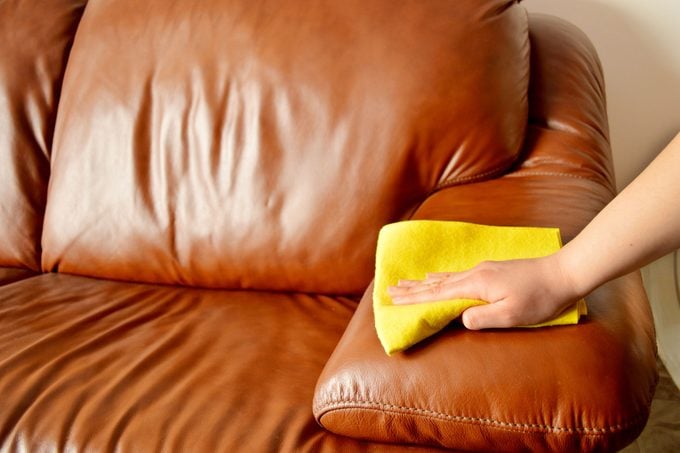
MANUEL-F-O/GETTY IMAGES
To bring a rich look back to dull or worn leather furniture , handbags or shoes, clean them with a mild solution of dish soap and water on a damp rag. Once the surface is dry, condition and polish the leather by putting a small amount of WD-40 on a rag and rubbing it into the leather.
Prevent fogging on the bathroom mirror
A thin film of WD-40 will keep your mirror clear of steam the next time you take a shower. To keep your mirror free of fog, dampen a rag with WD-40 and wipe the mirror down. Bonus: You’ll clean your mirror at the same time.
Maintain guitar strings
To clean, lubricate and prevent corrosion on guitar strings, apply a small amount of WD-40 after each use. Spray the WD-40 on a rag and wipe the rag over the strings rather than spraying directly on the strings—you don’t want WD-40 to build up on the guitar neck or body. It might seem like WD-40 is a fix-all after reading about all these uses, but there are still times when it’s better not to use it .
Untangle jewelry chains
Don’t risk breaking delicate chains as you detangle them. A spritz of WD-40 on the tangle will lubricate and loosen the knot so you can wear your jewelry again in no time.
De-grime and soften paintbrushes
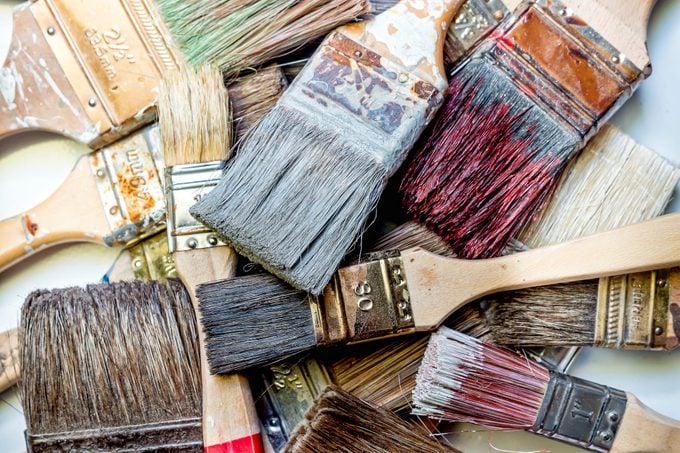
PRYZMAT/GETTY IMAGES
Don’t give up on that old paintbrush yet! To clean brushes, wash them in soap and water, then spray them with WD-40 to help remove stubborn paint.
To soften stiff bristles, simply spray them with WD-40 before storing them. Paint brushes preconditioned with WD-40 are also easier to clean after being used.
Loosen stuck LEGO bricks
Stuck-together LEGO bricks can ruin a good play session, but trying to pry them apart with a knife or other tool can leave marks on the pieces and, worse, injure you. Instead, apply a tiny amount of WD-40, then pull those bricks apart with ease.
Remove tight jewelry

JACOB WACKERHAUSEN/GETTY IMAGES
Tight rings aren’t just uncomfortable; if they get stuck, they can be painful and potentially dangerous. Spray a small amount of WD-40 onto the ring, and it should slide off. Be sure to wash your hands thoroughly with soap and water afterward.
Precautions when using WD-40
Before you break out the can of WD-40, it’s important to know the precautions you should follow when using it:
- Use it in a well-ventilated area.
- Avoid contact with your eyes.
- Avoid prolonged skin contact. Wash any skin that comes into contact with WD-40 with soap and water.
- Keep WD-40 away from flames and heat sources, as it’s flammable.
- The contents of a WD-40 can are under pressure, so take care not to puncture the can.
How not to use WD-40
While WD-40 has many uses in daily life, it’s important to take note of the times when you shouldn’t use the product. According to Harmanlikian, you shouldn’t use WD-40 on electronics, plastics, locks or exposed hardware, such as outdoor gate hinges. He points out that there are some special formulations of WD-40 that may be better suited to these uses.

Tags
Who is online
39 visitors


Now someone needs to post the article on 101 Uses for Duct Tape.
What's best for the door and key locks on my car?
Morning Greg...I was told by a lock smith to use dry graphite powder for all locks..sprinkle it on the key then put it into the lock and move it around..I assume you would get it at a hardware store over there...
WD40 is ok when you first use it but when it evaporates you are back to square one..
Thanks Shona, I'll give it a try.
Pencil lead is actually graphite and can be used as a lock lubricant.
I don't mind my Garage smelling like wd-40 or rust penetrant, but I don't want my whole house smelling like wd-40. Using it to condition a leather chair or to polish stainless steel appliances is going to far, maybe you'll get used to the smell but if you have visitors they'll think you've been rebuilding engines in your living room.
Evening... absolutely agree..the stuff reeks..